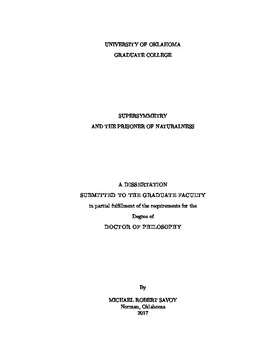| dc.description.abstract | In this work, I will address three concerns of supersymmetry. The first is the notion of naturalness and how much fine-tuning exists in a model. Historical measures, ∆ HS and ∆ BG , have led to an over estimate of the amount of fine-tuning and consequently to false claims about limits on supersymmetric particle masses. These supersymmetric particles masses have since been excluded, provoking claims that supersymmetry is fine-tuned and in a crisis. These claims are supported by incorrect measures of fine-tuning. In chapter 2, fine-tuning measures will be re-examined, leading to ∆ EW , a conservative estimate that is straight for-
ward to calculate and free of inherent cancellations and ambiguity. A limit on the amount of fine-tuning allowed for natural models is set, which will be used to constrain the parameter space.
The second concern in supersymmetry is determining how large the parameter space is. In choosing different archetypes of models, the parameter space is determined by a small set of input variables. In chapter 3, the archetypes scanned will include grand unification theories with gauge symmetries of either SO(10) or SU (5) as well as a general supergravity model. Furthermore, a non-unified model that has both anomaly and gravity mediation will be searched. Taking the upper limit allowed for natural supersymmetry models will constrain not only the inputs of the model, but also the outputs, such as particle masses, to lie within a finite amount of parameter space in which supersymmetry can live.
The third concern of supersymmetry is whether or not experiments will be able to find any new particles and verify supersymmetry. The large hadron collider is currently running, colliding protons with a center of mass energy of 14 TeV to generate new particles. Whether or not it will be able to find supersymmetric particles depends on how massive the new particles are, the frequency of their interactions, and how well the events generating new particles can be distinguished from the events containing known particles. A number of production channels will be searched: gluino pairs, same-sign di-bosons, higgsino pairs, and top squark pairs. These processes will determine the limit of how far in the parameter space the large hadron collider can search. It will be shown that for the unified models, the large hadron collider may exclude the entire parameter space if no supersymmetry signals are found. For the mixed anomaly and gravity mediation, an upgrade from 14 TeV to 33 TeV would be required to exclude the entire parameter space. Alternatively, instead of colliding protons, if the international linear collider is constructed, colliding electrons and positrons with enough energy to create Higgs bosons and higgsinos, the linear collider with center of mass energy of 600 GeV would be able to search the entire parameter space of any natural model. | en_US |
